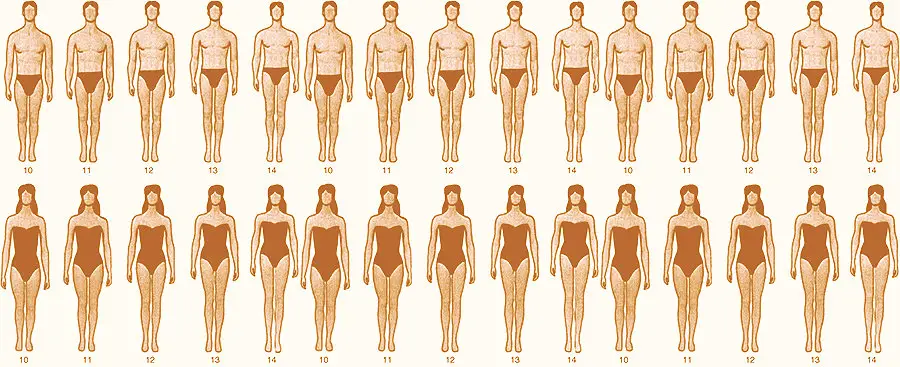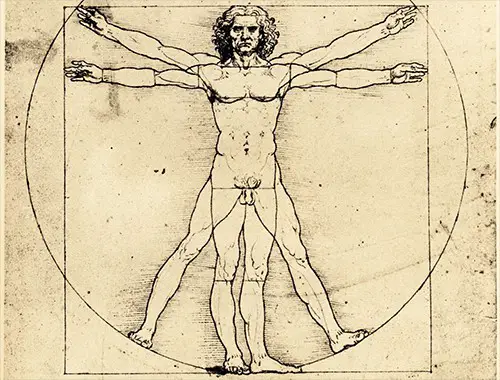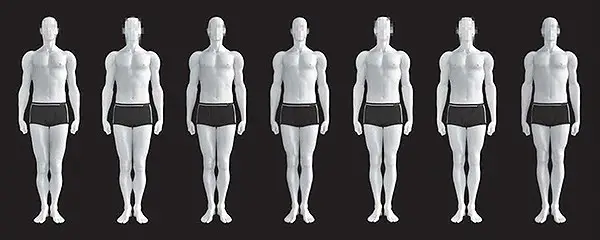
One of the least talked about body parts on men and women is their legs. Legs that are toned and muscular are ideal for men. Legs that are long and smooth are ideal for women. The leg to body ratio is another parameter on which we can judge attractiveness.
The leg to body ratio is the ratio of the total leg length to your height. The average person has a leg-to-body ratio between 1:1 to 1:1.5. Women have longer legs and have a higher leg-to-body ratio than men.
To best illustrate the leg to body ratio, you have to make body measurements for your torso length and your total height. You get your leg length by subtracting your torso length from your full height. If your torso length is 30 inches and your overall height in inches is 69 (5 ft 9 inches), your total leg length is 39. Therefore, your leg to body ratio is 30:39 or 1:1.3.
The Golden Ratio
People are drawn to everything that is visually balanced and proportionate. This penchant for proportion is how the Greeks formulated the “Golden Ratio.” The golden ratio, which is 1:1.618, is a ratio frequently found in nature. In art, the golden ratio is a number that defines the ideal and most attractive body proportions.

One of Leonardo DaVinci’s most famous work is the “Vitruvian Man.” In the year 1940, his creation referred to the human figure as the primary basis of proportion among the classical architecture. It also determined that 3.75:6.25 is the ideal proportion of the upper body and the lower body, close to the golden ratio.
Here is a table of the upper body and lower body ratios:
| Ratio Range |
>1:1.56 |
1:1.26 – 1.55 | 1:1 – 1.25 |
|
Body Ratio Type |
3-7 | 4-6 |
5-5 |
Long Legs are Markers of Attractiveness
Remember Cindy Crawford? She’s one of the “Big Five” original supermodels of the 80s and the 90s. She stands out at the height of 5 feet 9 inches (175 cm). The word supermodel normally conjures images of a model who is not just beautiful but also tall.

And how about Marcus Schenkenberg? He is the Dutch supermodel known for his Calvin Klein ads. He stands at 6 feet 4 inches (193 cm).
Height, or having proportionately long legs, does seem to matter if you want to become a successful model.
Leg to Body Ratio, Biological Fitness, and Health
There has always been something attractive about a tall person. Studies have shown that we, as human beings, are biologically attracted to a mate that can protect us and our offspring.
Biological Fitness
Studies have shown that a high LBR (leg-to-body ratio) is an indicator of biological fitness (Versluys et al. 2018). A fit partner is best likely to provide care, protection, and sustain the needs of their mate. They will also be more likely to pass on “good genes” to the offspring and be less likely to transmit any harmful pathogens. High LBR also reflects:
-
- Genetic diversity
- High socioeconomic status
- Developmental stability
- Good nutrition
- Biomechanical efficiency during locomotion
Health Links
According to some theories, women have longer legs than men because having long legs requires a wider pelvis. Having a wider pelvis allows for more natural childbirth and a heavy baby.
Women whose growth is interrupted due to psychological stress or nutritional deficiencies have short legs and a slightly longer torso. Longer legs also correlate with a better cardiovascular profile, which means less risk of heart disease, diabetes, cancer, lower blood pressure, and adult mortality rates.
Men with shorter legs are prone to higher triglycerides, which are risk factors for stroke and arterial disease.
What is Attractive: High or Low Leg to Body Ratio?
The leg to body ratio determines the nutritional health and development of a child. But in the field of aesthetics, LBR is considered a determinant of the attractiveness of both men and women.
It is not surprising that men find long-legged women to be more attractive than those with shorter legs. By the same token, women are more inclined to rate tall men as physically appealing.
Preference for Slightly Longer LBRs
A study led by Boguslaw Pawlowski (the University of Wroclaw in Poland) showed that the Polish male and female participants rated men and women whose legs are 5% longer than average as the most attractive. Legs that are 10% longer are the next most attractive.
According to Pawlowski, “long legs are signs of health.” Other research has also associated shorter legs with higher health risks such as cardiovascular disease and diabetes in both males and females.
Preference for High Female LBR and Low Male LBR
Another study Swami et al. (2006) examined the human leg to body ratio as a specific criterion among 71 undergraduates from the United Kingdom. In this study, participants rated physical attractiveness for five levels of LBR. The results showed that both males and females rated high LBR as more attractive when rating women and a lower LBR as more attractive when judging men.

Take a look at Nicole Kidman and Tom Cruise. Other than her picture-perfect facial features, Nicole’s leg length is 1.4 times her torso. And that adds to her physical attractiveness. On the other hand, Tom Cruise has a leg length that is the same as his torso length, making him more appealing and more masculine.
The results of many studies are consistent in showing that the LBR is a critical criterion when making judgments on men’s and women’s physical attractiveness.
How to Measure Leg to Body Ratio
Not everyone can have Nicole Kidman’s high LBR or Tom Cruise’s low LBR. But if you want to know if your LBR is anywhere near ideal, you should learn how to calculate your leg to body ratio. LBR is measured by doing the following:
- Have the person you are measuring remove their shoes
- Make them stand straight up against a wall
- Measure the person’s height from head to feet.
- Have them sit straight on a chair
- Measure their torso from the top of their head to the top of the seat of the chair. This measurement is the torso length.
- Subtract the torso’s length from the total height. This measurement is the leg length.
- Divide the leg length by the torso length. This is the leg to body ratio.

Growth Problems Affecting Leg to Body Ratio
A person’s physical development manifests in changes to head circumference, height, and weight. If normal growth is interrupted, it is often the sign of a growth disorder.
-
- Turner’s Syndrome – this is a condition that only affects women. It occurs when one of the X chromosomes is missing. Numerous medical and developmental problems resulting from this disease include short height, undeveloped ovaries, and heart defects.
- Achondroplasia – caused by mutations in the FGFR3 gene, Achondroplasia is a bone growth disorder affecting the arms and legs. Symptoms include dwarfism, large head size, limited range of motion at the elbows, little fingers, and average intelligence.
- Down Syndrome – is caused when there is an abnormal cell division of chromosome 21. It either results in an extra full or partial copy of the chromosome. This disorder causes developmental changes and abnormal physical features because of additional genetic material.
Does Good Posture Affect Height?
Can poor posture affect your height? The answer is yes. Thoracic kyphosis is the rounding of your upper back. It can be caused by genetics, injury, brittle bones, or lack of physical activity. Depending on the severity, thoracic kyphosis can be pretty noticeable.
But there is a simple solution to this problem: having good posture. Practicing good posture increases your height and improves the way you look in a relatively short period. The secret formula? Combine good posture with exercises to stretch and strengthen your spine. It’s as easy as that. Physical therapists can also help in improving your spine. For more info on proper posture, visit our guide.
Good posture also leads to numerous health benefits and relieves physical ailments such as neck and backaches. Good posture takes the load off your spine. Practice good posture by walking tall and sitting straight. To assist your posture in sitting, try using a small rolled up hand towel and placing it in the low back lumbar area for support. Consider using ergonomic chairs or a standing desk. And finally, always remember to give your spine a break.
To fix forward head posture, perform this exercise repeatedly:
Most people wish they were taller. Standing in a crowd of short-legged people can gratifying, especially if all eyes are on you. You may not have the ideal leg-to-body ratio, but you can still be attractive and desirable in the other aspects of your being. Make the most of what you have by optimizing your posture.
Most importantly, if attractiveness is your priority, consider one of our custom facial reports. Your jawline and facial structure are far more important than your physique.
As a result, compared to other body parts, people tend to initially focus on the face, look at the face for longer durations, and return attention to the face more frequently than other body parts during person perception. – Gervais et al., 2013

